This article will provide an in-depth introduction to Fractal Bitcoin, including its technical background and the latest developments in its ecosystem.
Author: Louis Wang, Core Contributor at Biteye
Editor: Crush, Core Contributor at Biteye
Community: @BiteyeCN
* The full text is approximately 5200 words, with an estimated reading time of 10 minutes
Are there significant limitations hidden behind Bitcoin?
Why do transaction fees soar to staggering levels?
In the face of these challenges, are there new solutions?
In recent months, Fractal Bitcoin has gained significant attention, utilizing "Bitcoin-style" scaling to achieve higher transaction processing capabilities for the Bitcoin network. How does it accomplish this?
This article will provide an in-depth introduction to Fractal Bitcoin, including its technical background and the latest developments in its ecosystem, which you won't want to miss!
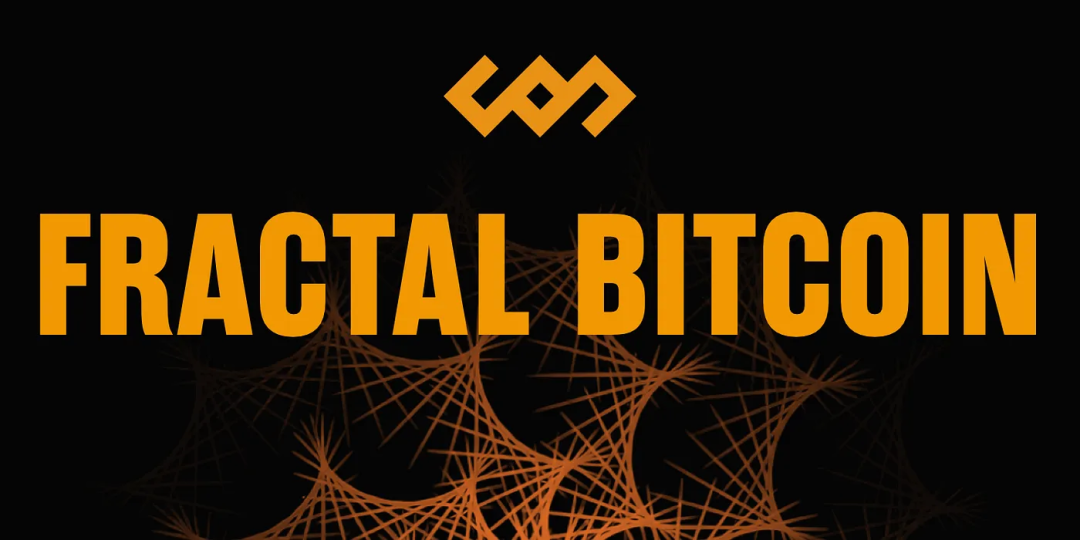
01 Limitations of the Bitcoin Network
Although the Bitcoin network possesses the strongest decentralization and security features, its inherent limitations restrict the diverse development of the network:
1. Slow transaction speed, with an average block time of 10 minutes leading to low network throughput, making it difficult to meet the demands of complex application scenarios, severely impacting user experience;
2. During network congestion, transaction costs soar, deterring ordinary users;
3. The simple scripting language of the Bitcoin network limits its smart contract functionality, even innovative protocols like Ordinals have to rely on off-chain indexing, not to mention achieving DeFi composability like Ethereum.
In response to these challenges, various scaling solutions have emerged in the market, most of which execute EVM or BitVM independently through sidechains, relegating the Bitcoin network to a data availability layer.
Against this backdrop, Fractal Bitcoin, launched by the UniSat team, showcases another possibility, attracting widespread attention with its unique "Bitcoin-style" scaling approach.
02 Bitcoin-style Scaling
Traditional Bitcoin scaling solutions such as Lightning Network, Segregated Witness, increasing block size, and sidechains can be likened to adding lanes or optimizing traffic rules on an existing highway.
Fractal Bitcoin, on the other hand, employs a multi-layer, recursive architecture, comparable to upgrading a single-plane highway to a multi-dimensional traffic network.
Most importantly, Fractal Bitcoin maintains compatibility with the Bitcoin core protocol, akin to equipping a car with a more advanced rocket propulsion system without changing its essence.

https://x.com/fractal_bitcoin/status/1812849645267415050
Name Origin
The name Fractal Bitcoin draws from the concept of "fractal" in mathematics, emphasizing self-similarity and continuous recursion.
It essentially operates as a sidechain running in parallel with the Bitcoin mainnet, closely connected to the mainnet through a node called Fractal.
Innovative Aspects
The core innovation of Fractal lies in its tree-structured recursive expansion layer architecture (BCSP). This architecture allows for increased transaction processing capacity by adding layers without modifying the Bitcoin core protocol.
This design not only significantly enhances the network's parallel processing capabilities but also opens up possibilities for complex applications involving high-frequency and large-volume transactions.
In terms of performance, Fractal reduces block time to 30 seconds, significantly improving transaction confirmation speed and network throughput.
The base layer provides 20 times the capacity of the Bitcoin mainnet, and with each additional layer, this multiplier grows exponentially, creating new possibilities for high-performance application scenarios.
In terms of security, Fractal Bitcoin employs a hybrid mining mechanism that cleverly balances decentralization and security.
In every three blocks, two are mined by permissionless miners, and one is jointly mined with Bitcoin. This not only enhances the network's decentralization but also leverages Bitcoin's powerful hash rate to ensure security.
Notably, within three weeks of launch, Fractal's joint mining hash rate has stabilized at over 40% of Bitcoin's total hash rate, attracting participation from well-known mining pools including MaxiPool, SpiderPool, and f2pool.
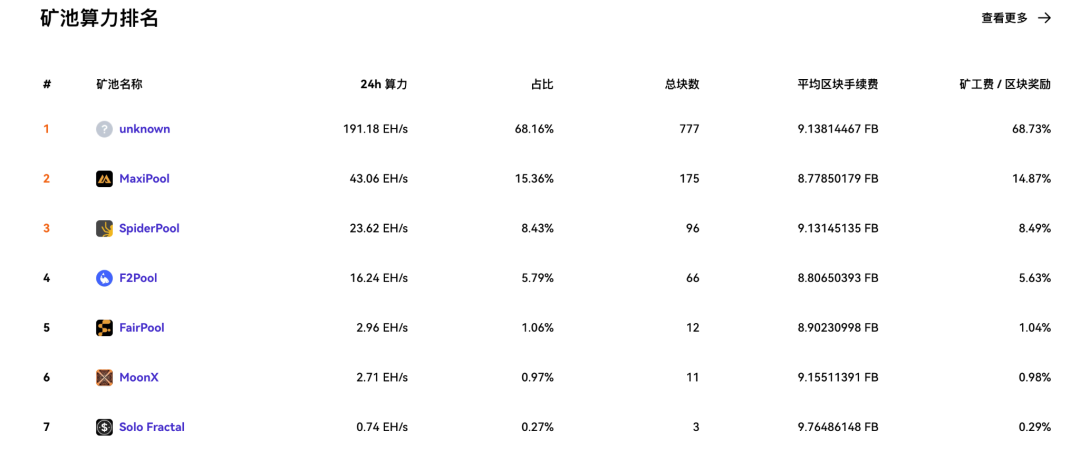
https://www.okx.com/zh-hans/web3/explorer/fractal-bitcoin?channelId=x001en
In terms of functional expansion, Fractal has implemented the OP_CAT opcode, achieving Turing-complete smart contracts on a Bitcoin-based platform.
OP_CAT is a simple concatenation operation that, when combined with other opcodes, can realize complex smart contract logic.
The high compatibility of Fractal with the Bitcoin ecosystem is another important feature.
It is fully compatible with protocol standards such as BRC-20 and Ordinals, allowing users to operate using the same addresses between the Bitcoin mainnet and Fractal, utilizing familiar Bitcoin infrastructure.
This design simplifies the user experience, similar to switching EVM networks in a wallet, reducing operational risks and creating conditions for seamless migration of existing Bitcoin assets and infrastructure.
03 Significance of the Fractal Network
The emergence of Fractal Bitcoin not only provides an innovative scaling solution for the Bitcoin network but also opens up new possibilities for the future development of the Bitcoin ecosystem.
It addresses a series of long-standing issues through technological innovation while maintaining the core values of Bitcoin.
Quickly Passing Controversial Proposals
The Bitcoin ecosystem lacks a leading role like Vitalik and the Ethereum Foundation to promote network development. Opinions on the OP_CAT opcode within the Bitcoin community remain divided, and when it will go live is still uncertain.
Fractal can implement OP_CAT and other "controversial" opcode proposals like ZK native verification more quickly, effectively rehearsing Bitcoin-native inscription-based smart contracts for the Bitcoin mainnet.
Low Risk, High Efficiency, and User-Friendly
The 100% compatibility of Fractal with the Bitcoin mainnet allows for seamless migration of various RC20 assets and infrastructure on existing BTC without code modification. This compatibility provides developers and users with a low-risk, high-efficiency innovative platform.
Its mechanism of 1/3 joint mining with the Bitcoin mainnet (where mainnet miners can mine a Fractal block every 90 seconds) not only ensures security but also provides additional revenue for miners.
Pointing the Direction for Bitcoin Ecosystem Development
From a broader perspective, Fractal has the potential to become an innovation engine for the Bitcoin ecosystem. It offers developers an experimental network with incentives, users, and a real market.
Success on Fractal may indicate the future development direction of the Bitcoin mainnet, and once the main chain supports new features, assets on Fractal may also cross back to the mainnet.
This model is expected to attract more developers, innovations, and users, making Fractal a highly valuable ecosystem, thereby exerting a greater influence and driving force on the Bitcoin mainnet, forming a positive feedback loop.
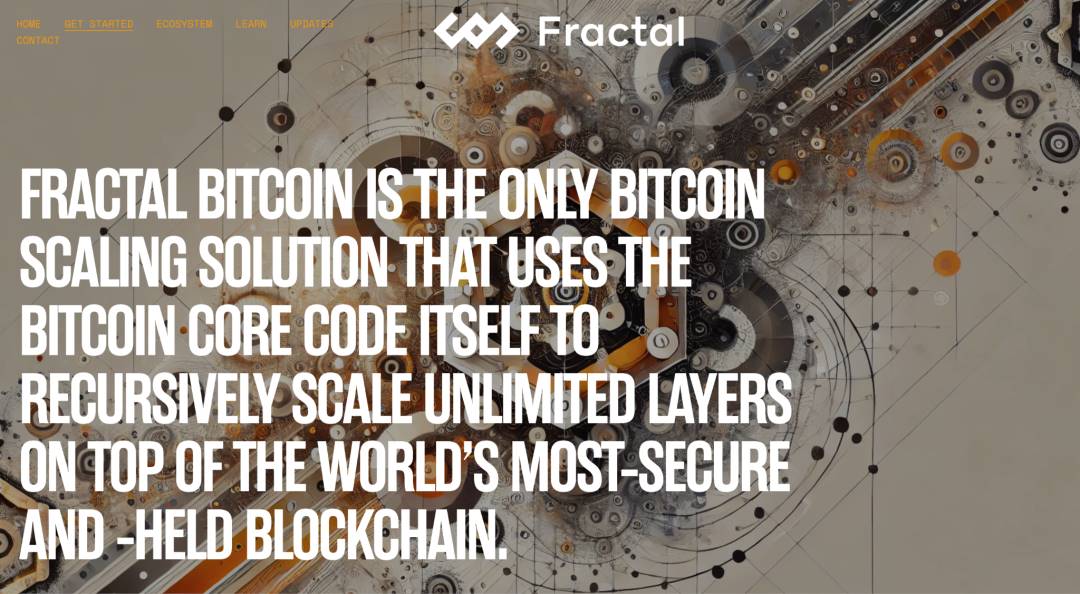
https://www.fractalbitcoin.io/
Mutual Achievement with UniSat
In this grand vision, the UniSat team is undoubtedly the most suitable entity to promote the development of Fractal.
Looking back at the last wave of inscription frenzy, UniSat stood out in fierce competition with its open-source Bitcoin wallet and tools for minting and trading.
The core advantage of the UniSat team lies in its rich experience in Bitcoin large block development. As supporters of Bitcoin large blocks, team members have participated in Bitcoin forks and have long been involved in BSV development.
This background enables them to rapidly iterate products and respond quickly to market demands.
Fractal can be seen as a continuation of UniSat's grand vision, laying the infrastructure and highways for more innovations they wish to achieve, while Fractal naturally reaches UniSat's 1 million weekly active users, providing a solid potential user base.

https://x.com/unisat_wallet/status/1781543425755803987
Market Recognition
The market's response to Fractal Bitcoin has also been quite positive.
Since its mainnet launch on September 9, in just three weeks, the on-chain user count has exceeded 3.8 million, and the circulating market cap of its native token $FB has surpassed $30 million.
More notably, the new homogeneous token standard OP_CAT has sparked heated discussions on the Fractal network, with the first token under this standard, $CAT, already exceeding a market cap of $40 million, reflecting the market's recognition of Fractal Bitcoin's potential.
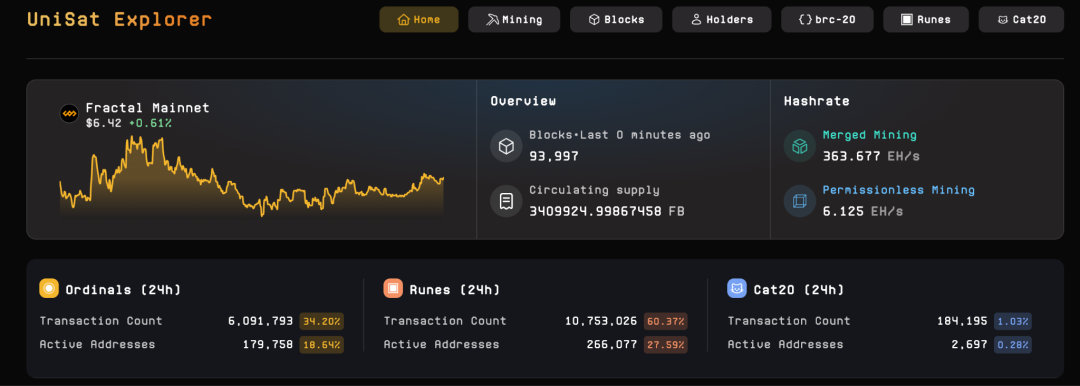
https://fractal.unisat.io/explorer
04 Ecosystem Progress
According to data from the Fractal Ecosystem, 140 projects have been recorded so far, primarily focusing on NFT projects and infrastructure.
BTC Smart Contracts Still Under Development
This distribution reflects the developmental stage of the ecosystem: although OP_CAT has opened up the possibility of smart contracts, developing complex applications based on it will still take time.
Therefore, in the short term, we see projects mainly concentrated in two categories:
First, operation-oriented NFT projects
Second, necessary infrastructure construction
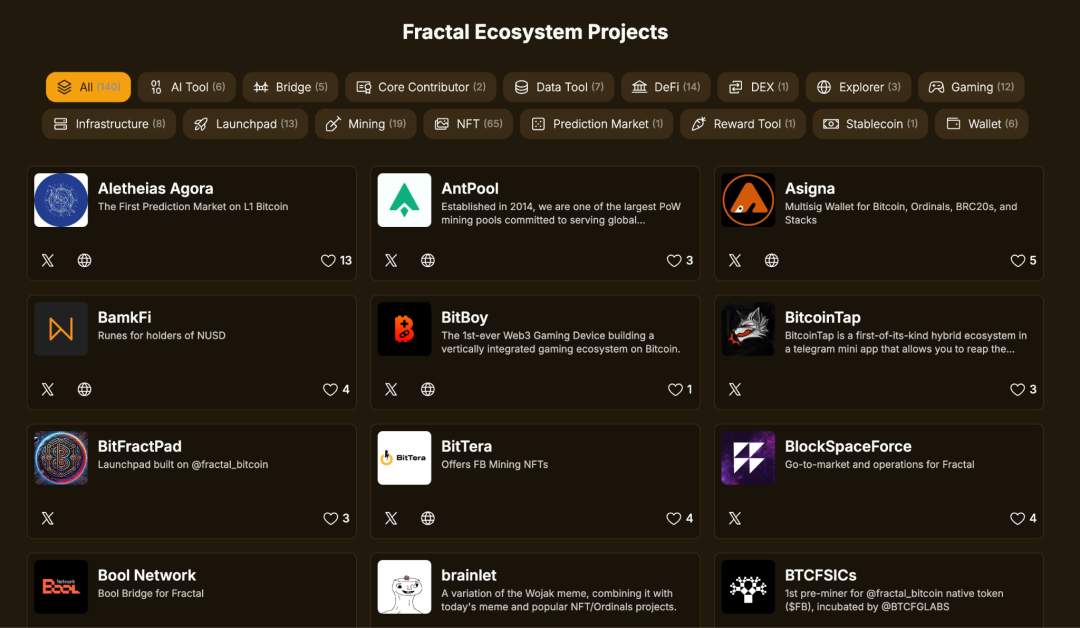
https://fractalecosystem.io/projects
Fractal Applications
Lorenzo, the founder of UniSat, believes that the types of projects users may focus on include:
Cross-chain bridges: facilitating asset flow between the Bitcoin mainnet and Fractal.
Trading-related applications: including native swaps, DEX, and NFT markets.
Large-scale user interaction applications: such as DID, credential issuance, and voting governance.
In terms of asset categories, Fractal supports not only Ordinals NFTs, BRC20 tokens, and Runes but also gives rise to CAT20 assets based on the CAT protocol.
The CAT Protocol (Covenant Attested Token) is an innovative Bitcoin token protocol based on UTXO, verified by miners, and managed through smart contracts.
Its core lies in the OP_CAT opcode, which enables more complex transactions.

CAT20 has sparked a craze on Fractal similar to the early inscription wave, with related tool projects flourishing and daily trading volumes being considerable.
The UniSat team is providing comprehensive support for CAT20, including wallet functionality, browser display, and API support. The official announcement has stated that CAT20 transfers and wallet displays will launch on October 21, with the CAT20 trading market going live on October 22.
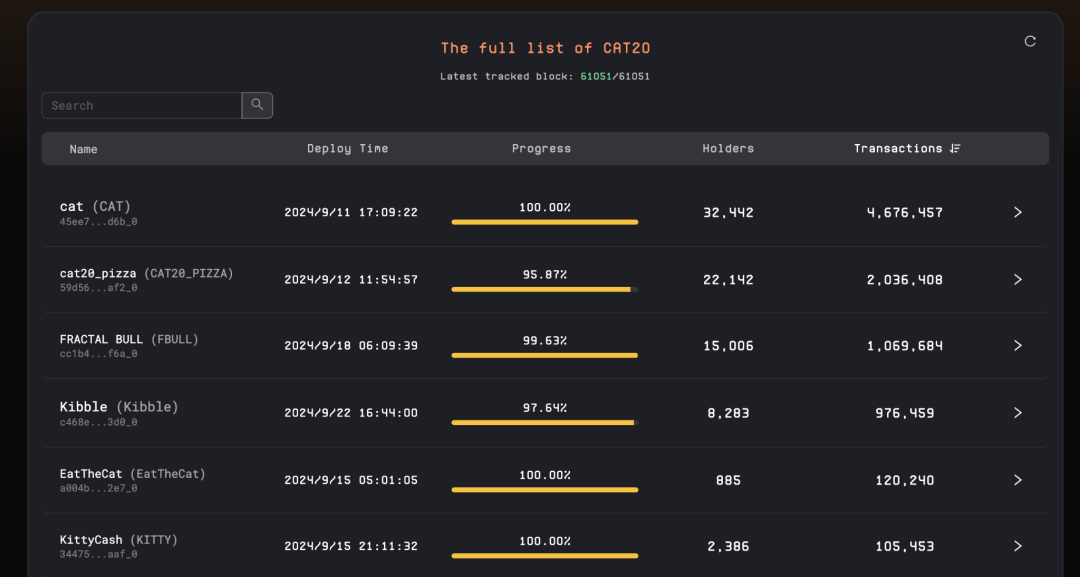
https://explorer.unisat.io/fractal-mainnet/
The development in the DeFi sector mainly focuses on cross-chain bridges and DEX.
The UniSat team is developing various cross-chain solutions, with PizzaSwap set to launch first, supporting multiple bridged assets. In terms of DEX, projects like MotoSwap are exploring inscription-based smart contracts to achieve AMM trading experiences, despite significant technical challenges.
User adoption projects cover multiple fields, including gaming, AI, and prediction markets.
Notably, considering the gaming background of Fractal founder Lorenzo and the parallel characteristics of Fractal, Bitcoin network gaming could become a promising track. Uni Worlds, as one of the first funded projects by Fractal, is working to become a gaming infrastructure within the Bitcoin ecosystem.
05 Challenges Facing the Fractal Network
The Fractal ecosystem is rapidly developing, covering multiple levels from infrastructure to innovative applications. At the same time, the challenges faced by Fractal are also evident:
Technical Implementation Difficulty
Implementing smart contracts and gaming functions on the Bitcoin network, while attractive, is technically complex and requires extensive research and exploration.
Bitcoin scripts are less well-known and more complex to use compared to mainstream languages like Rust or Solidity, and such high barriers may limit the number of developers participating in Fractal, thereby slowing the expansion of the ecosystem. There is still a lot of work to be done in ecosystem building and developer relations.
High Selling Pressure from Miners
Miners, as potential sources of selling pressure for POW tokens, can receive dual mining rewards of BTC and FB by participating in joint mining. Which token are miners more likely to sell to cover costs?
Fractal introduced many large mining farms early in its launch, with joint mining hash power exceeding 40% of Bitcoin's hash power. It can be inferred that Fractal has reached a certain consensus with large mining farms, but the behavior of unknown mining farms and individual miners remains difficult to predict. Whether FB can withstand long-term selling pressure is still uncertain.
Overall, Fractal may face significant technical challenges in the short term and user adoption issues in the medium term, but in the long run, it could have a positive impact on the development of the Bitcoin mainnet.
We look forward to more developers getting involved, nurturing more Bitcoin-native projects, and jointly promoting the development of innovation.
06 Conclusion
Fractal Bitcoin, as a unique Bitcoin expansion solution, injects vitality and new possibilities into the Bitcoin ecosystem.
It addresses network expansion issues by proposing a tree-structured recursive expansion layer architecture that enhances the throughput of the Bitcoin network.
The unique joint mining mechanism improves the network's security and decentralization, serving as a true testing ground for the Bitcoin network, providing valuable user data and feedback, and is expected to become a guiding star for Bitcoin's development.
免责声明:本文章仅代表作者个人观点,不代表本平台的立场和观点。本文章仅供信息分享,不构成对任何人的任何投资建议。用户与作者之间的任何争议,与本平台无关。如网页中刊载的文章或图片涉及侵权,请提供相关的权利证明和身份证明发送邮件到support@aicoin.com,本平台相关工作人员将会进行核查。




